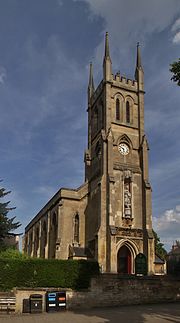Church in Banbury, United Kingdom
| St John the Evangelist Church | |
|---|---|
 | |
| 52°03′29″N 1°20′23″W / 52.058°N 1.3397°W / 52.058; -1.3397 | |
| Location | Banbury |
| Country | United Kingdom |
| Denomination | Roman Catholic |
| Website | BanburyCatholicChurches.org.uk |
| History | |
| Status | Parish church |
| Founder(s) | Abbé Pierre Hersent |
| Dedication | John the Evangelist |
| Associated people | Fr Joseph Fox Dr William Tandy |
| Architecture | |
| Functional status | Active |
| Heritage designation | Grade II listed |
| Designated | 8 July 1975 |
| Architect(s) | Hickman & Derick Augustus Pugin |
| Style | Gothic Revival |
| Groundbreaking | 1835 |
| Completed | 1838 |
| Administration | |
| Province | Birmingham |
| Archdiocese | Birmingham |
| Deanery | Banbury |
| Parish | St John the Evangelist |
St John the Evangelist Church is a Roman Catholic parish church in Banbury, Oxfordshire, England. It was built from 1835 to 1838 in the Gothic Revival style with parts of it designed by Augustus Pugin. It is located on the corner of South Bar Street and Dashwood Road south of the town centre. It is a Grade II listed building.
History
Foundation
After the Reformation, Catholics could go to a chapel in Warkworth Castle to celebrate Mass. It was home to the Holman family and then the Eyre family. In 1806, the castle was demolished and a chapel was built in Overthorpe, Northamptonshire. In 1828, a mission was started in Banbury by the priest at Overthorpe, Abbé Pierre Hersent.
Construction
Abbé Pierre Hersent bought the site of the current church, the old Calthorpe Manor House. He died in 1833, and the church was built by his successors, Fr Joseph Fox and Dr William Tandy. Building lasted from 1835 to 1838. The church was designed by Oxford-based architects, Charles Randall Hickman and John Macduff Derick. Derick also designed Holy Trinity Church, Chipping Norton. John Talbot, 16th Earl of Shrewsbury provided the stone for the construction of the church, the organ, and the tower clock, originally made by W. Allam of London in 1762. In 1839, Dr William Tandy paid Augustus Pugin to design the presbytery, chancel and its fittings, and stained glass.
Developments
In 1847, Dr William Tandy invited the Sisters of Saint Paul of Chartres to create a community in Banbury, buying St John's Priory for them. The community became the motherhouse of the sisters in the UK until it moved to St Paul's Convent in Selly Park. In 1933, the original tower clock was replaced. In June 1938, a refurbishment was completed, with statues added to the church designed by Richard Lockwood Boulton.
Parish
St John the Evangelist Church is its own parish and works with the nearby parish of St Joseph the Worker Church in Bretch Hill and St Thomas of Canterbury Church in Wroxton. St John the Evangelist Church has three Sunday Masses at 4:00pm on Saturday and at 8:45am and 11:15am on Sunday. St Joseph the Worker Church also has three Sunday Masses at 6:00pm on Saturday and at 10:00am and 5:30pm on Sunday.
Interior
See also
References
- Church of St John the Evangelist Roman Catholic Church, Banbury from British Listed Buildings, retrieved 9 June 2022
- Banbury Deanery from Immaculate Conception Church, Bicester, retrieved 6 June 2022
- Historic England. "Church of St John the Evangelist (1046906)". National Heritage List for England. Retrieved 9 June 2022.
- ^ Historic England, Banbury - St John the Evangelist, Taking Stock, retrieved 9 June 2022
- T. Neuman (ed.), The London Gazette, Part 2, 5 December 1838, p. 2937.
- Call to England from SistersofStPaulSellyPark.org.uk, retrieved 10 June 2022
- Churches from Archdiocese of Birmingham, retrieved 9 June 2022
External links
- Official website
 Media related to Church of St John the Evangelist, Banbury at Wikimedia Commons
Media related to Church of St John the Evangelist, Banbury at Wikimedia Commons
| Banbury | |
|---|---|
| Estates |
|
| Education |
|
| Hospitals |
|
| Newspapers | |
| Miscellaneous |
|
- Banbury
- Roman Catholic churches in Oxfordshire
- Grade II listed churches in Oxfordshire
- Grade II listed Roman Catholic churches in England
- Gothic Revival church buildings in England
- Gothic Revival architecture in Oxfordshire
- 19th-century Roman Catholic church buildings in the United Kingdom
- 1835 establishments in England
- Roman Catholic churches completed in 1838
- Religious organizations established in 1835


